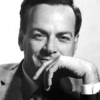Richard P. Feynman

Richard P. Feynman
Richard Phillips Feynmanwas an American theoretical physicist known for his work in the path integral formulation of quantum mechanics, the theory of quantum electrodynamics, and the physics of the superfluidity of supercooled liquid helium, as well as in particle physics for which he proposed the parton model. For his contributions to the development of quantum electrodynamics, Feynman, jointly with Julian Schwinger and Sin-Itiro Tomonaga, received the Nobel Prize in Physics in 1965...
NationalityAmerican
ProfessionPhysicist
Date of Birth11 May 1918
CountryUnited States of America
With the exception of gravitation and radioactivity, all of the phenomena known to physicists and chemists in 1911 have their ultimate explanation in the laws of quantum electrodynamics.
There were several possible solutions of the difficulty of classical electrodynamics, any one of which might serve as a good starting point to the solution of the difficulties of quantum electrodynamics.
Because the theory of quantum mechanics could explain all of chemistry and the various properties of substances, it was a tremendous success. But still there was the problem of the interaction of light and matter.
It is a curious historical fact that modern quantum mechanics began with two quite different mathematical formulations: the differential equation of Schroedinger and the matrix algebra of Heisenberg. The two apparently dissimilar approaches were proved to be mathematically equivalent.
The extreme weakness of quantum gravitational effects now poses some philosophical problems; maybe nature is trying to tell us something new here: maybe we should not try to quantize gravity.
Trying to understand the way nature works involves a most terrible test of human reasoning ability. It involves subtle trickery, beautiful tightropes of logic on which one has to walk in order not to make a mistake in predicting what will happen. The quantum mechanical and the relativity ideas are examples of this.
No one really understands quantum mechanics.
The Quantum Universe has a quotation from me in every chapter - but it's a damn good book anyway.
A philosopher once said, 'It is necessary for the very existence of science that the same conditions always produce the same results.' Well, they don't!
Working out another system to replace Newton's laws took a long time because phenomena at the atomic level were quite strange. One had to lose one's common sense in order to perceive what was happening at the atomic level.
When I would hear the rabbi tell about some miracle such as a bush whose leaves were shaking but there wasn't any wind, I would try to fit the miracle into the real world and explain it in terms of natural phenomena.
What goes on inside a star is better understood than one might guess from the difficulty of having to look at a little dot of light through a telescope, because we can calculate what the atoms in the stars should do in most circumstances.
We seem gradually to be groping toward an understanding of the world of subatomic particles, but we really do not know how far we have yet to go in this task.
We get the exciting result that the total energy of the universe is zero. Why this should be so is one of the great mysteries - and therefore one of the important questions of physics. After all, what would be the use of studying physics if the mysteries were not the most important things to investigate?